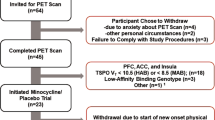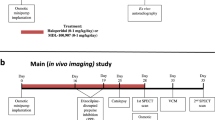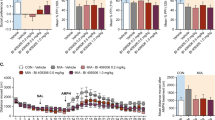Abstract
The present study was undertaken to examine whether the second generation antibiotic drug minocycline attenuates behavioral changes (eg, acute hyperlocomotion and prepulse inhibition (PPI) deficits) in mice after the administration of the N-methyl-D-aspartate (NMDA) receptor antagonist (+)-MK-801 (dizocilpine). Dizocilpine (0.1 mg/kg)-induced hyperlocomotion was significantly attenuated by pretreatment with minocycline (40 mg/kg). Furthermore, the PPI deficits after a single administration of dizocilpine (0.1 mg/kg) were attenuated by pretreatment with minocycline (10, 20, or 40 mg/kg), in a dose-dependent manner. Moreover, in vivo microdialysis study in the free-moving mice revealed that pretreatment with minocycline (40 mg/kg, i.p.) significantly attenuated the increase of extracellular dopamine (DA) levels in the frontal cortex and striatum after administration of dizocilpine (0.1 mg/kg), suggesting that the inhibition of dizocilpine-induced DA release by minocycline may, at least in part, be implicated in the mechanism of action of minocycline with respect to dizocilpine-induced behavioral changes in mice. These findings suggest that minocycline could attenuate behavioral changes in mice after the administration of the NMDA receptor antagonist dizocilpine. Therefore, it is possible that minocycline would be a potential therapeutic drug for schizophrenia.
Similar content being viewed by others
Log in or create a free account to read this content
Gain free access to this article, as well as selected content from this journal and more on nature.com
or
References
Abi-Dargham A, Moore H (2003). Prefrontal DA transmission at D1 receptors and the pathology of schizophrenia. Neuroscientist 9: 404–416.
Al-Amin HA, Schwarzkopf SB (1996). Effects of the PCP analog dizocilpine on sensory gating: potential relevance to clinical subtypes of schizophrenia. Biol Psychiatry 40: 744–754.
Aronson AL (1980). Pharmacotherapeutics of the newer tetracyclines. J Am Vet Med Assoc 176: 1061–1067.
Bakshi VP, Geyer MA (1998). Multiple limbic regions mediate the disruption of prepulse inhibition produced in rats by the noncompetitive NMDA antagonist dizocilpine. J Neurosci 18: 8394–8401.
Barza M, Brown RB, Shanks C, Gamble C, Weinstein L (1975). Relation between lipophilicity and pharmacological behavior of minocycline, doxycycline, tetracycline, and oxytetracycline in dogs. Antimicrob Agents Chemother 8: 713–720.
Blum D, Chtarto A, Tenenbaum L, Brotchi J, Levivier M (2004). Clinical potential of minocycline for neurodegenerative disorders. Neurobiol Dis 17: 359–366.
Braff DL, Freedman R (2002). Endophenotypes in studies of the genetics of schizophrenia. In: Davis KL, Charney D, Coyle JT, Nemeroff C (eds). Neuropsychopharmacology—The Fifth Generation of Progress. Lippincott Williams & Wilkins: Philadelphia, PA. pp 703–716.
Braff DL, Geyer MA (1990). Sensorimotor gating and schizophrenia. Human and animal model studies. Arch Gen Psychiatry 47: 181–188.
Chen M, Ona VO, Li M, Ferrante RJ, Fink KB, Zhu S et al (2000). Minocycline inhibits caspase-1 and caspase-3 expression and delays mortality in a transgenic mouse model of Huntington disease. Nat Med 7: 797–801.
Coyle JT (1996). The glutamatergic dysfunction hypothesis for schizophrenia. Harv Rev Psychiatry 3: 241–253.
Domercq M, Matute C (2004). Neuroprotection by tetracyclines. Trends Pharmacol Sci 25: 609–612.
Du Y, Ma Z, Lin S, Dodel RC, Gao F, Bales KR et al (2001). Minocycline prevents nigrostriatal dopaminergic neurodegeneration in the MPTP model of Parkinson's disease. Proc Natl Acad Sci USA 98: 14669–14674.
Geyer MA, Krebs-Thomson K, Braff DL, Swerdlow NR (2001). Pharmacological studies of prepulse inhibition models of sensorimotor gating deficits in schizophrenia: a decade in review. Psychopharmacology (Berl) 156: 117–154.
Goldman-Rakic PS (1999). The physiological approach: functional architecture of working memory and disordered cognition in schizophrenia. Biol Psychiatry 46: 650–661.
Goldman-Rakic PS, Castner SA, Svensson TH, Siever LJ, Williams GV (2004). Targeting the dopamine D1 receptor in schizophrenia: insights for cognitive dysfunction. Psychopharmacology (Berl) 174: 3–16.
Hashimoto K, Fukushima T, Shimizu E, Komatsu N, Watanabe H, Shinoda N et al (2003). Decreased serum levels of D-serine in patients with schizophrenia: evidence in support of the N-methyl-D-aspartate receptor hypofunction hypothesis of schizophrenia. Arch Gen Psychiatry 60: 572–576.
Hashimoto K, Okamura N, Shimizu E, Iyo M (2004). Glutamate hypothesis of schizophrenia and approach for possible therapeutic drugs. Curr Med Chem CNS Agents 4: 147–154.
Hashimoto K, Shimizu E, Iyo M (2005). Dysfunction of glia–neuron communication in pathophysiology of schizophrenia. Curr Psychiatry Rev 1: 151–163.
Hashimoto K, Tomitaka S, Bi Y, Narita N, Minabe Y, Iyo M (1997). Rolipram, a selective phosphodiesterase type-IV inhibitor, prevents induction of heat shock protein HSP-70 and hsp-70 mRNA in rat retrosplenial cortex by the NMDA receptor antagonist dizocilpine. Eur J Neurosci 9: 1891–1901.
Hashimoto K, Tsukada H, Nishiyama S, Fukumoto D, Kakiuchi T, Iyo M (2007). Protective effects of minocycline on the reduction of dopamine transporters in the striatum after administration of methamphetamine: a PET study in conscious monkeys. Biol Psychiatry, in press.
Javitt DC, Zukin SR (1991). Recent advances in the phencyclidine model of schizophrenia. Am J Psychiatry 148: 1301–1308.
Krystal JH, D'Souza DC, Petrakis IL, Belger A, Berman RM, Charney DS et al (1999). NMDA agonists and antagonists as probes of glutamatergic dysfunction and pharmacotherapies in neuropsychiatric disorders. Harv Rev Psychiatry 7: 125–143.
Leriche L, Schwartz JC, Sokoloff P (2003). The dopamine D3 receptor mediates locomotor hyperactivity induced by NMDA receptor blockade. Neuropharmacology 45: 174–181.
Levin ED, Petro A, Caldwell DP (2005). Nicotine and clozapine actions on pre-pulse inhibition deficits caused by N-methyl-D-aspartate (NMDA) glutamatergic receptor blockade. Prog Neuropsychopharmacol Biol Psychiatry 29: 581–586.
Lipina T, Labrie V, Weiner I, Roder J (2005). Modulators of the glycine site on NMDA receptors, D-serine and ALX 5407, display similar beneficial effects to clozapine in mouse models of schizophrenia. Psychopharmacology (Berl) 179: 54–67.
Long LE, Malone DT, Taylor DA (2006). Cannabidiol reverses MK-801-induced disruption of prepulse inhibition in mice. Neuropsychopharmacology 31: 795–803.
Morimoto T, Hashimoto K, Yasumatsu H, Tanaka H, Fujimura M, Kuriyama M et al (2002). Neuropharmacological profile of a novel potential atypical antipsychotic drug Y-931 (8-fluoro-12-(4-methylpiperazin-1-yl)- 6H-[1]benzothieno[2,3-b][1,5] benzodiazepine maleate). Neuropsychopharmacology 26: 456–467.
Okamura N, Hashimoto K, Shimizu E, Kumakiri C, Komatsu N, Iyo M (2004). Adenosine A1 receptor agonists block the neuropathological changes in rat retrosplenial cortex after administration of the NMDA receptor antagonist dizocilpine. Neuropsychopharmacology 29: 544–550.
Olney JW, Farber NB (1995). Glutamate receptor dysfunction and schizophrenia. Arch Gen Psychiatry 52: 998–1007.
Perry W, Geyer MA, Braff DL (1999). Sensorimotor gating and thought disturbance measured in close temporal proximity in schizophrenic patients. Arch Gen Psychiatry 56: 277–281.
Ralph-Williams RJ, Lehmann-Masten V, Geyer MA (2003). Dopamine D1 rather than D2 receptor agonists disrupt prepulse inhibition of startle in mice. Neuropsychopharmacology 28: 108–118.
Schwabe K, Koch M (2004). Role of the medial prefrontal cortex in N-methyl-D-aspartate receptor antagonist induced sensorimotor gating deficit in rats. Neurosci Lett 355: 5–8.
Smith K, Leyden JJ (2005). Safety of doxycycline and minocycline: a systematic review. Clin Ther 27: 1329–1342.
Stirling DP, Koochesfahani KM, Steeves JD, Tetzlaff W (2005). Minocycline as a neuroprotective agent. Neuroscientist 11: 308–322.
Swerdlow NR, Geyer MA (1998). Using an animal model of deficient sensorimotor gating to study the pathophysiology and new treatments of schizophrenia. Schizophr Bull 24: 285–301.
Tamminga CA (1998). Schizophrenia and glutamatergic transmission. Crit Rev Neurobiol 12: 21–36.
Thomas M, Le WD (2004). Minocycline: neuroprotective mechanisms in Parkinson's disease. Curr Pharm Des 10: 679–686.
Tikka T, Fiebich BL, Goldsteins G, Keinanen R, Koistinaho J (2001). Minocycline, a tetracycline derivative, is neuroprotective against excitotoxicity by inhibiting activation and proliferation of microglia. J Neurosci 21: 2580–2588.
Tsukada H, Miyasato K, Nishiyama S, Fukumoto D, Kakiuchi T, Domino EF (2005). Nicotine normalizes increased prefrontal cortical dopamine D1 receptor binding and decreased working memory performance produced by repeated pretreatment with MK-801: a PET study in conscious monkeys. Neuropsychopharmacology 30: 2144–2153.
Varty GB, Bakshi VP, Geyer MA (1999). M100907, a serotonin 5-HT2A receptor antagonist and putative antipsychotic, blocks dizocilpine-induced prepulse inhibition deficits in Sprague–Dawley and Wistar rats. Neuropsychopharmacology 20: 311–321.
Verma A, Moghaddam B (1996). NMDA receptor antagonists impair prefrontal cortex function as assessed via spatial delayed alternation performance in rats: modulation by dopamine. J Neurosci 16: 373–379.
Wang X, Zhu S, Drozda M, Zhang W, Stavrovskaya IG, Cattaneo E et al (2003). Minocycline inhibits caspase-independent and -dependent mitochondrial cell death pathways in models of Huntington's disease. Proc Natl Acad Sci USA 100: 10483–10487.
Weinberger DR, Egan MF, Bertolino A, Callicott JH, Mattay VS, Lipska BK et al (2001). Prefrontal neurons and the genetics of schizophrenia. Biol Psychiatry 50: 825–844.
Wu DC, Jackson-Lewis V, Vila M, Tieu K, Teismann P, Vadseth C et al (2002). Blockade of microglial activation is neuroprotective in the 1-methyl-4-phenyl-1,2,3,6-tetrahydropyridine mouse model of Parkinson disease. J Neurosci 22: 1763–1771.
Yee BK, Chang DL, Feldon J (2004). The Effects of dizocilpine and phencyclidine on prepulse inhibition of the acoustic startle reflex and on prepulse-elicited reactivity in C57BL6 mice. Neuropsychopharmacology 29: 1865–1877.
Yong VW, Wells J, Giuliani F, Casha S, Power C, Metz LM (2004). The promise of minocycline in neurology. Lancet Neurol 3: 744–751.
Yrjanheikki J, Keinanen R Pellikka M, Hokfelt T, Koistinaho J (1998). Tetracyclines inhibit microglial activation and are neuroprotective in global brain ischemia. Proc Natl Acad Sci USA 95: 15769–15774.
Yrjanheikki J, Tikka T, Keinanen R, Goldsteins G, Chan PH, Koistinaho J (1999). A tetracycline derivative, minocycline, reduces inflammation and protects against focal cerebral ischemia with a wide therapeutic window. Proc Natl Acad Sci USA 96: 13496–134500.
Zhang L, Kitaichi K, Fujimoto Y, Nakayama H, Shimizu E, Iyo M et al (2006a). Protective effects of minocycline on behavioral changes and neurotoxicity in mice after administration of methamphetamine. Prog Neuropharmacol Biol Psychiatry 30: 1381–1393.
Zhang L, Shirayama Y, Shimizu E, Iyo M, Hashimoto K (2006b). Protective effects of minocycline on 3,4-methylenedioxymethamphetamine-induced neurotoxicity in serotonergic and dopaminergic neurons of mouse brain. Eur J Pharmacol 544: 1–9.
Zhu S, Stavrovskaya IG, Drozda M, Kim BY, Ona V, Li M et al (2002). Minocycline inhibits cytochrome c release and delays progression of amyotrophic lateral sclerosis in mice. Nature 417: 74–78.
Acknowledgements
This study was supported in part by grants from the Minister of Education, Culture, Sports, Science, and Technology of Japan (KH), the Ministry of Health, Labor and Welfare of Japan (KH), and the Program for Promotion of Fundamental Studies in Health Sciences of the National Institutes of Biomedical Innovation (KH). We thank Dr Nori Takei (Department of Psychiatry, Hamamatsu University School of Medicine) for his valuable suggestion on statistical analysis.
Author information
Authors and Affiliations
Corresponding author
Rights and permissions
About this article
Cite this article
Zhang, L., Shirayama, Y., Iyo, M. et al. Minocycline Attenuates Hyperlocomotion and Prepulse Inhibition Deficits in Mice after Administration of the NMDA Receptor Antagonist Dizocilpine. Neuropsychopharmacol 32, 2004–2010 (2007). https://doi.org/10.1038/sj.npp.1301313
Received:
Revised:
Accepted:
Published:
Issue date:
DOI: https://doi.org/10.1038/sj.npp.1301313
Keywords
This article is cited by
-
A CCR5 antagonist, maraviroc, alleviates neural circuit dysfunction and behavioral disorders induced by prenatal valproate exposure
Journal of Neuroinflammation (2022)
-
Acute stress-induced change in polysialic acid levels mediated by sialidase in mouse brain
Scientific Reports (2019)
-
Preventive effects of minocycline in a neurodevelopmental two-hit model with relevance to schizophrenia
Translational Psychiatry (2016)
-
Minocycline exacerbates apoptotic neurodegeneration induced by the NMDA receptor antagonist MK-801 in the early postnatal mouse brain
European Archives of Psychiatry and Clinical Neuroscience (2016)
-
Tspyl2 Loss-of-Function Causes Neurodevelopmental Brain and Behavior Abnormalities in Mice
Behavior Genetics (2016)



